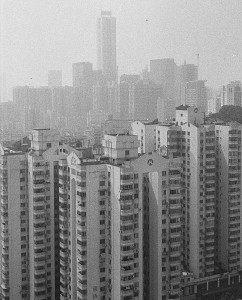At a construction and energy conservation conference that opened March 29 in Beijing, a Ministry of Housing and Construction official revealed that construction in China only has a 25–30 year lifespan, reports China Daily.

How long will these 15-year-old buildings in Guangzhou remain standing? (photo/ Don Weinland)
Chou Baoxing, vice-director of the Ministry of Housing and Construction, said at the Sixth International Green Building and Energy Conservation Conference that although China produces 2 billion square meters in new construction annually, these new buildings have a maximum lifespan of only 30 years. The lack of longevity in Chinese construction has led to the accumulation of billions of tons of construction refuse, China Youth reports.
An article at the People’s Daily reports that 30–40 percent of city garbage is construction refuse. The article states that an astronomical amount of this kind of refuse is created annually and now surrounds many Chinese cities.
High turnover rates for building may help to explain China’s ferocious appetite for construction materials. China currently consumes 40 percent of the world’s cement and steel. But as for the short-lived nature of Chinese construction, there are multiple explanations.
Sources report that suppliers often shortchange developers, who in turn shortchange consumers. The 1993 Consumer Rights Protection Law was drafted before housing was considered a tradable product by the government. Therefore consumer rights protected in the 16-year-old law do not extend to the housing sector.
Economist and blogger Zheng Fengtian acknowledges sub-standard construction practices in a post:
而据专家分析,目前我国建筑质量出现最多的问题是施工质量问题,目前不少建筑物存在钢筋不达标,混凝土保护层不达标等严重问题,偷工减料很普遍。
According to professional analysis, most problems concerning my country’s architectural quality are construction problems. Currently existing problems with construction material include sub-standard rebar and sub-standard concrete protective layering, among other serious problems. Shoddy construction and the use of inferior materials are commonplace.
In July 2009, after a 13-storey building toppled over in Shanghai’s Minhang District killing one construction worker, the Ministry of Housing conducted inspections in 90 cities at 180 different construction sites. According to China Youth, 96 percent passed the inspection.
Some sources say the problem isn’t faulty construction. Yang Tao writes in a blog that those in power are more concerned with short term political achievement than with harm to the environment or conservation of resources, often leading to the demolition of healthy buildings.
对于权力而言,建筑垃圾不是问题,资源浪费不是问题,民众房屋寿命更不是问题,权力追求的高楼之高、广场之大,城市的整齐、划一和一尘不染的美观,以及这背后的政绩。
As far as the powers are concerned, construction refuse is not a problem, the wasting of resources is not a problem, and even more so, the lifespan of the people’s housing is not a problem. The powers are after the height of the skyscraper, the vastness of the square, the tidiness of the city, uniform and untouched aestheticism—and the political achievements behind the curtain.
Yang Tao writes that even a perfect city will not satisfy the ambitions of a short-term official.
短暂的任期和异地为官的制度,让官员习惯性地短视,他们需要的是在自己的五年甚至更短的一届任期做出看得见的政绩,所以,别人建的楼和广场,永远都是别人的政绩 … 没有最大只有更大
Short terms and the system placing officials outside of their home districts make them habitually short-sighted. Within their five year—or perhaps even shorter—term they must produce visible political achievements. So a building or a square built by someone else will always be someone else’s achievement … There is no biggest, only bigger.
A post at lousun.com states that the rate of demolition in China is equivalent to 40 percent of current construction rates—as China builds 10 buildings, they tear four down. This blogger writes that many buildings subject to demolition are healthy.
近年来,中国很多属于正常使用年限的建筑被强行拆除,大大缩短了住宅的使用寿命,这也不符合节能与建设节约型社会的要求,是造成资源浪费的又一大原因。
Recently, many buildings with normal age depreciations have been forcibly torn down, greatly reducing the lifespan of residential usage. This does not coincide with society’s request for energy conservation and economic construction. It’s another great cause of the waste of resources.
With skyrocketing housing prices and fear of a growing real estate bubble, high demolition rates and dangerously shoddy construction remains an enigma. Blogger kkdstt says the situation is truly characteristic to China.
花最贵的价钱买最短命的建筑,这样的事情只有在和谐中国能够发生。
Spending the greatest amount of money to buy the housing with the shortest lifespan—this kind of thing could only happen in harmonious China.
These conditions put the livelihood of the people at risk, kkdstt writes.
在房价一飞冲天的年代,没有人关注建筑质量,没有人关注和百姓联系的民生。大家想的是如何把老百姓从他们栖息了千年的土地上赶走,然后找一帮所谓的专家搞一些百姓听不懂、看不明白的概念方案 … 只要楼盖起来了,房价涨起来了,GDP增长了,财政收入增加了,即使房子是纸糊的,与我何干。
In an age when housing prices have gone through the roof, no one is concerned about construction quality; no one is concerned about the common people’s livelihood. Everyone is thinking about how to drive the commoners from their ancestral homes—finding a band of so called professionals to craft concepts that the people don’t understand … As long as the buildings go up, housing prices rise, the GDP and the government’s income increases, housing could be made of paper for all I care.
A code was passed during a 2006 government workshop stipulating that all major buildings be built with a lifespan of 100 years and all normal buildings be built to last 50–100 years. Despite this code and other inspection procedures, a lack of longevity throughout the industry persists.
Perhaps the 2008 Sichuan Earthquake that reportedly killed at least 68,000 people is an example of the dangers of sub-standard construction. The earthquake leveled more than 7,000 schools, many of which were compared to Tofu due to their altogether flimsiness.







6 comments
If you got to keep up the GDP, you must build, build, build. And if you can get free money to do so, and land is not available, why no tear down some 15 year old one, and build some new ones.
Or why why not tear down some timeless 500 year old buildings so that you can tear down your crappy new ones 15 years later.
China’s ravenous consumption of steel and concrete has created many problems for our country’s building industry, or should I say, what is left of our building industry.
That report has been shown to be an utter and complete misquote:
http://www.zonaeuropa.com/201004a.brief.htm#014harr
Have you been brainwashed by the CCP? It’s pretty common knowledge that some of these buildings won’t last; some get gutted after 10 years.
Maybe you haven’t bought a home in one of these horrible buildings. You can dump a lot of money, then watch in horror as your prize investment deteriorates – cracks, leaks, peeled flooring, odor, broken toilet – in only a few or even several years. And I’m not talking about the cheapos either.
It’s also not just buildings either. That high-speed rail system will be a disaster in 10 years.
That’s an interesting link “Wgj”.
What happens after 25 to 30 years of sustained building in China though? Now, there is tremendous incentive to tear down buildings, in South Korea, that have been up for only 30 years, since banks and construction companies can make money from such. Why is there any reason to believe that the same pattern will not be repeated in China?